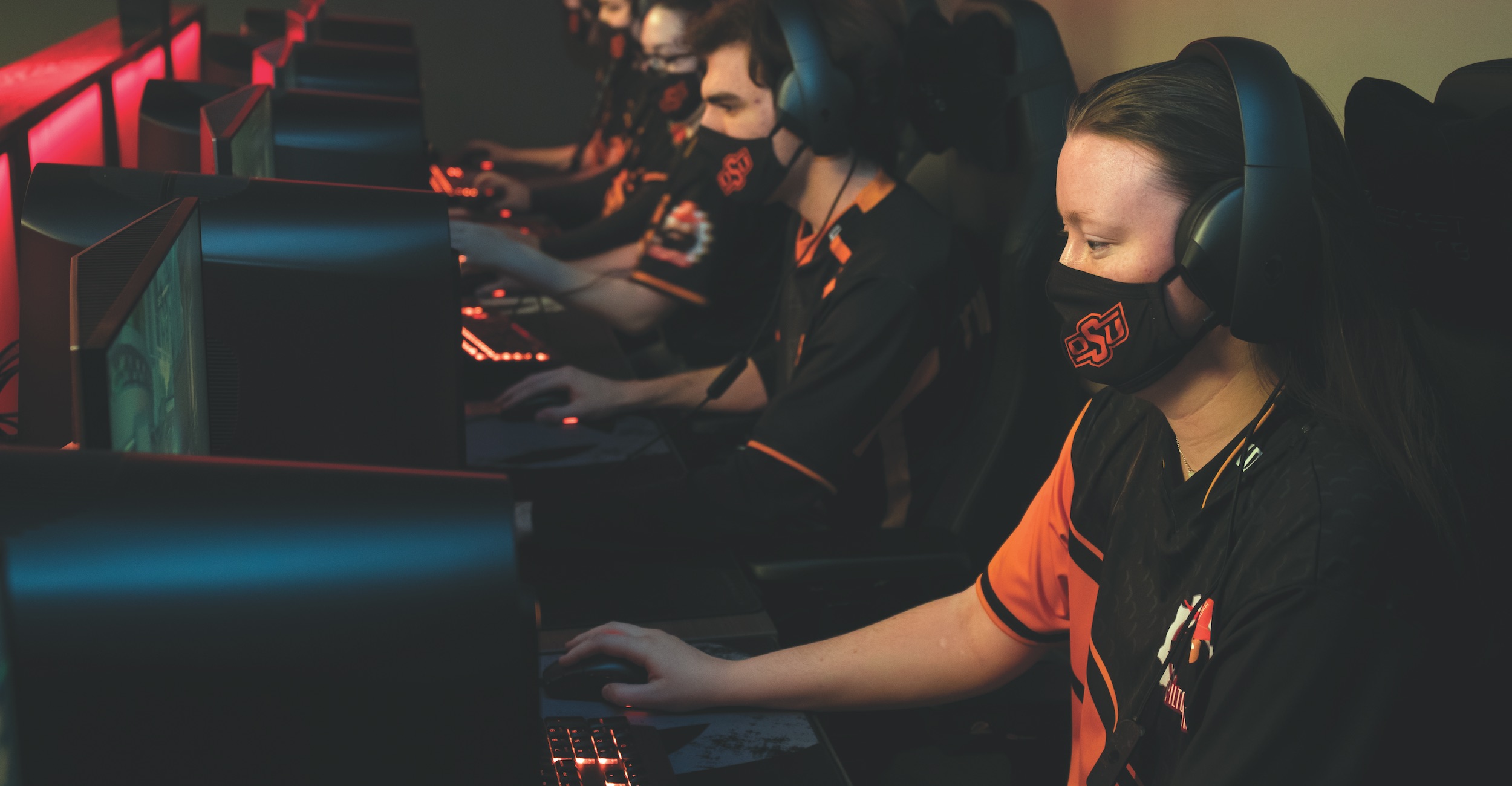
OSU primed to lead Big 12 with new esports arena
Monday, April 12, 2021
Media Contact: Mack Burke | Editorial Coordinator | 405-744-5540 | editor@okstate.edu
Pop quiz: What sporting event attracted the most viewers in FY 2019? If you answered the Super Bowl, then you’d be wrong. While the NFL’s season finale brought in over 98 million viewers, that distinction went to … a video game tournament.
With nearly 100 million unique viewers — most through streaming services like Twitch — the “League of Legends” World Championship finals achieved something that would’ve been unthinkable just 10 years ago. It was a remarkable moment, but it was no one-off. The skyrocketing popularity of esports — a broad term encompassing the vast universe of online gaming — is not a fad; it’s a movement. And OSU has now entered the arena.
Much more than a playground
This spring, OSU opened a brand-new, state-of-the-art esports arena in the Student Union. With 40 high-powered PCs, a Twitch station, green screen and a slew of other amenities, the 1,690 square-foot arena is a gamers’ playground. But it’s a lot more than that.
“We’re primed to be the Big 12 leader,” said Adam Barnes, Student Union assistant director of meeting and conference services. “There’s nobody we know of that is as far along in terms of a dedicated esports arena — not some computer lab out in the corner of campus somewhere, but a dedicated space. We strategically chose the Student Union because it’s the heart of campus.”
For OSU esports, the arena represents a giant leap, and its potential impact extends far beyond its walls. Varsity Esports Foundation Executive Director Bubba Gaeddert, an OSU alumnus, said universities are seeing a major return on these kinds of investments in recruiting, potential sponsorships and brand awareness.
“There’s no ceiling on it,” he said. “It’s the fastest-growing industry in the world. Strictly competitive esports marketing is valued at almost $2 billion, but the ecosystem around gamers who are also influencers is a $25 billion industry. And that’s not even including the broader gaming industry.”
Gaeddert’s fellow OSU alumnus Bill Young, head of games at Twitch, said OSU already has strong programs that could easily feed into an esports/ gaming curriculum. Having an arena is another major boost to OSU’s allure as a destination for young people looking to build their future in the gaming world.
“Esports is one important component of a much larger gaming industry,” he said. “In fact, at $180 billion [in revenue] in 2020, video games are now bigger than movies and North American sports — combined.
“There are over 260,000 people employed in the video game industry, a number growing by almost 5 percent per year in the U.S. The disciplines needed by the gaming business are remarkably varied, ranging from art and design to computer programming. But don’t forget about business, architecture, finance, IT/IS, marketing and public relations. Universities worldwide have already recognized this as a significant growth area and are now competing for the best and brightest who are dedicated to building careers in the games business.”
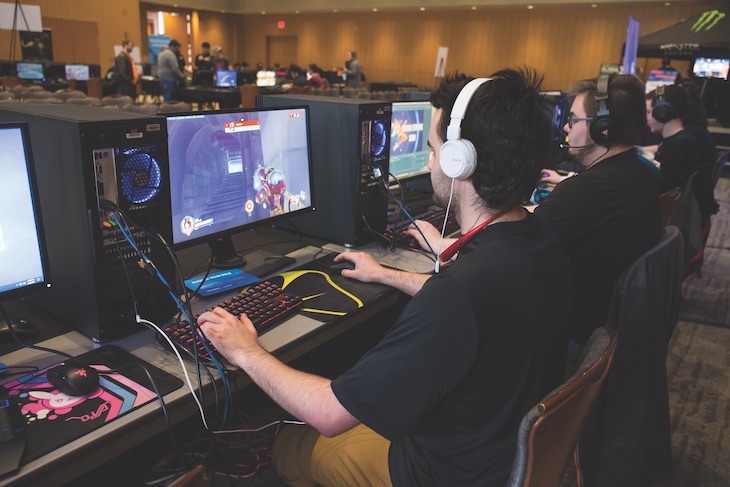
Press start to begin
The arena’s roots can be traced back to a cross-country road trip in the summer of 2018.
Shaun Noll, the Student Union meeting and conference services manager who serves as the full-time advisor for the largest student group on campus — Gamers of OSU — set off with a Cowboy contingent in search of universities that were “doing esports right.”
Noll, accompanied by Barnes, Student Union Senior System Administrator Chris Conway and then-Student Union Director and Assistant Vice President Mitch Kilcrease, wanted to see if a robust esports push would make sense for a Power 5 institution. On the road, they looked for inspiration at the University of Utah, Boise State University, University of California-Irvine and the headquarters of gaming giant Blizzard Entertainment.
“As we went on this tour, we realized that esports definitely fit on college campuses, but it really fit with student affairs,” Barnes said. “Inclusion, retention, engagement ... it checked all of the boxes. It brought people together.”
Noll and Barnes saw tremendous potential and decided to get students involved. So they took a follow-up visit to the West Coast in 2019 with new Student Union Director Tracie Brown, Student Union IT Assistant Director Mike Peaster, Student Union Multimedia Producer Coleton Gambill and four officers from the Gamers of OSU club. They returned to Blizzard headquarters and esports heavyweight UC-Irvine. By the time they headed home, they had a crystallized vision for the new arena, and construction began in the fall of 2019.
Brown isn’t a gamer, but she said backing the arena project was an easy call once she saw the potential firsthand.
“What was our ‘why’? Really it comes down to one thing for me: We are here for the students. We know this is going to be a recruiting tool, but we also know that it’s going to provide opportunities for retention. An engaged and involved student is going to stay.”
On top of that, she said the esports arena is a truly inclusive space — a place to belong.
“Esports transcends everything,” she said. “From an inclusive perspective, it runs the gamut. There’s no limit. That’s exciting to me.”
The arena is located in the Cowboy Underground, in a space that Barnes said had been underutilized. Instead of just a reimagining of that space — which at one point was a bowling alley — the esports arena has transformed it into something completely new and different.
“It gives us an opportunity to engage our students and be on the cutting edge of something that’s extremely popular and inclusive,” Noll said.
Brown is quick to credit her predecessor and the many people who helped bring the project to fruition, like Noll and Barnes, as well as Conway, who handled the installation and configuration of technology, and Student Union Building Operations maintenance staff member Al Maxwell, who did the majority of the construction and brought forward design recommendations. Noll said the project wouldn’t have been possible without the Student Union leadership, the Student Affairs Office and the backing of leadership. And, of course, the students.
Gamers of OSU President Sam Williams said the planning process was very student-oriented and the group’s feedback was incorporated at every step along the way.
“Of course, the arena is an amazing opportunity for students and faculty of OSU to be able to partake in a common interest and meet like-minded individuals,” Williams said. “That fits into our club’s goals as a student organization and nonprofit. The gaming arena is much larger than that, however, as it represents OSU recognizing and jumping into the esports industry.”
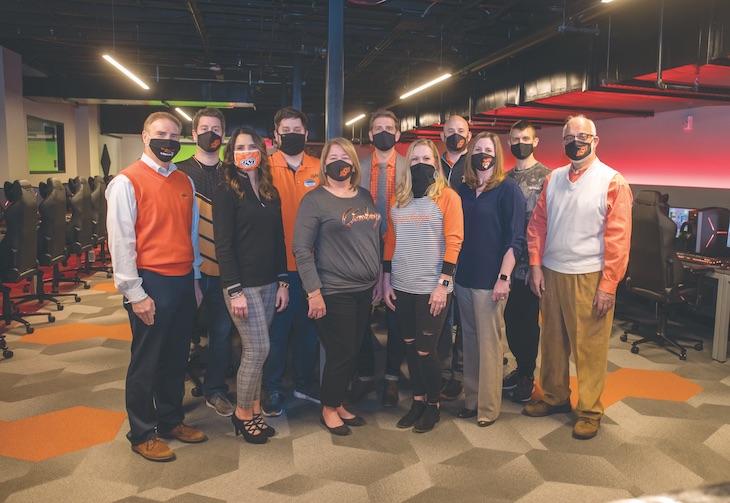
In the game, in the classroom
As building got under way, Noll and Barnes started conversations with assistant professor Skye Cooley in the School of Media and Strategic Communication about exploring options for an academic unit or entry point associated with esports.
A committee was formed with representatives from the School of Media and Strategic Communication, O’Colly Media Group, Student Union Operations and Brand Management. The committee devised a new esports certificate program. The program was approved by the OSU/A&M Board of Regents in March and now awaits approval from the state regents. It incorporates marketing and production-related curriculum and aims to provide an introduction to the world of esports from a business and event-planning perspective.
By the numbers
Cooley said the plan is to launch the program this fall and continue to hone it to students’ needs and interests, building intentionally, one step at a time.
“I know nothing about esports, but I do know about changing media landscapes and changing technology,” Cooley said. “We live our lives in front of screens now, and esports presents an opportunity to expand and flex what media can be as a science, as a discipline, both academically and in terms of placing people in careers. Every business now is a media business in some shape, form or fashion. We’ve got faculty here who get it, and we’re looking for something we can center around that’s future-oriented.”
Cooley sees esports as a relatable and exciting way of attracting students interested in media that goes beyond the bounds of traditional media.
“We normally get people who are interested in public relations or communications skills, and of course journalism. Esports brings in all kinds of students — students who might be interested in programming, coding, big data systems, research, graphic design or entertainment.
“Because concurrent [enrollment] allows high school students in the state of Oklahoma to take classes toward their degree, this would be open to them. And what more awesome program could you get as a high school student to start your college career than taking an esports related class that would introduce you to media studies and get you interested in the media universe.”
Barnes said the academic component adds another dimension to the arena, making it a learning lab, giving students the knowledge and tools to produce esports content right from the start.
Director of Student Media Max Andrews, for instance, will be teaching a class on how to produce streaming shows, similar to ESPN’s SportsCenter but for the wide world of esports.
Andrews, who was instrumental in forming the certificate committee, wants to broadcast events from OSU’s new arena with students behind the camera. Those are the kinds of opportunities — the chance to learn and do — that make this program so attractive to students.
“It’s not just an auxiliary or a plaything,” Barnes said. “It has an air of legitimacy to it when the university backs it with a degree or a certificate. This will be a place for students to put what they’re learning into practice and get that out-of- classroom experience. This is the perfect foundation to build on.”
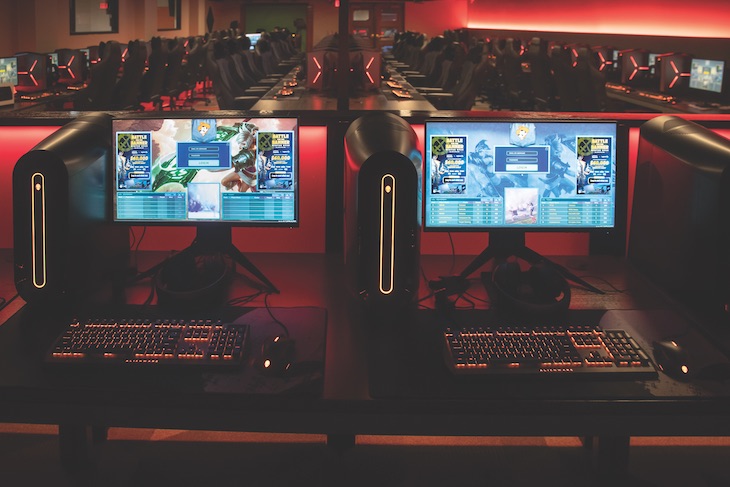
Leveling up
Will OSU be enticing rising esports stars to campus with scholarships? Will there ever be a full academic unit dedicated to esports? Noll and Barnes feel those are exciting questions that the arena and certificate program will help answer. Cooley said there’s no lack of ambition, but they want to be as thoughtful in that pursuit as they have been to this point.
“That’s the next challenge,” he said. “The first couple of years, we’ll be monitoring where students go after they complete the certificate, getting feedback on the other offerings that are out there, and then seeing what we can do better.”
“The industry is so huge. You can do everything, from being a broadcaster to producing the content to designing games, designing logos and art, to being an actual competitor. It’s really holistic, and I think figuring out where we want to land with our specialties and offerings is the next phase. We’re going to do that with the help of the students.”
Gaeddert, who describes his Varsity Esports Foundation as the “connective tissue of esports in the scholastic space,” said hundreds of schools offer degrees, certificates, minors or courses in esports. The COVID-19 pandemic pushed a lot of schools to take an expedited approach to esports, he said, but OSU was already taking intentional steps and continues to do things the right way.
“Because people at the administration level got in with early adoption, OSU is better off,” he said. “[OSU] spent almost two years building this certificate program, where a lot of colleges have just decided that esports is a sexy term and seen it as a way to just slap an ‘E’ on their communications class and call it good. ... But there are no ‘nerds’ in the class, there’s no one who actually knows the stuff. This is happening across the country and it’s sad. It’s almost predatorial. [OSU] is taking the path to actually creating esports education for its students.”
From a recognition standpoint, Gaeddert said it doesn’t hurt that OSU counts some major esports names among its alumni — head of games at Twitch Bill Young, Envy Games President Geoff Moore, NCSOFT Vice President Kendall Boyd, Special Reserve Games CEO and product designer Jeff Smith, and Intel Gaming Global Account Manager Brian Bruning.
“This is just another way for OSU to connect with students, to show what’s out there, what’s possible,” he said.
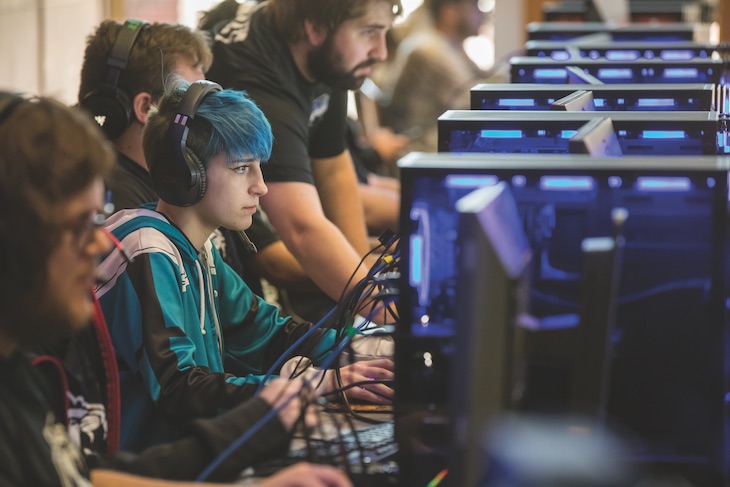
Global gamification
In 1977, Milton Bradley spokesperson Michael Moone infamously predicted video games would be a passing fad, brushing them off as “just another gadget.”
The industry’s blossoming into a multibillion-dollar juggernaut proved Moone’s prediction spectacularly wrong, but the industry is still fraught with misconceptions and continues to be underestimated even today.
The world is changing, but Gaeddert said the conversation surrounding video games and esports is often stuck in the past.
“The average age of a gamer is 35,” he said. “So what that means is alumni, boosters and foundation supporters, they’re probably also playing some sort of video game. The video game industry as a whole is worth over $150 billion worldwide. Half of that is mobile. If you play Candy Crush or Words with Friends, you’re a gamer.
“Gamification is everywhere. We as a society have perpetuated video gamers as young kids in their basements drinking soda and eating chips. That’s what we’ve been doing for 60 years. The problem is that [demographic] is a minority.”
When Envy Gaming President Geoff Moore graduated from OSU in 1989, there was no esports industry. As the industry grew, esports became a bigger blip on his radar, but the industry’s growth potential came into focus in 2018, pushing him to take the leap into the esports world.
“When Envy started talking me through the audience size, the different games they were in, things like that, as someone who had been part of a group that had been responsible for selling the [National Hockey League] in Texas, esports did not seem like a risky choice by comparison,” Moore said.
“Just in the game of Overwatch — which is a popular game but not the most popular game — there are more people in north Texas playing Overwatch than playing high school football in the entire state of Texas. So when you start comparing the participatory numbers with other things that are wildly successful, you can really start putting things into context.”
Moore said esports is still in its early life cycle. When it matures, he said it’s “going to be a monster.” It’s unique, too, in that esports are global and inclusive, transcending nationality, gender, race, body type, height, weight and, in many cases, disability.
“There are almost no barriers, and there are hundreds of different types of games so there’s something for almost everybody,” he said. “That’s a very powerful variable. ... Gaming is not limited by anything but an internet connection.”
Moore said gamification is everywhere, and that, even more than esports, is at the heart of the cultural sea change surrounding gaming. He believes esports will evolve and be absorbed into the wider culture.
“Esports isn’t even really the thing; it’s the gamification of life,” he said. “That’s the thing, esports is just the competitive gaming element.
“Gamification really just means what are your rewards for achieving certain things? Starbucks, for example, has a great rewards program. They’ve gamified selling coffee. So when people say ‘I’m interested in gaming,’ that can be applied to everything because everything in the world is going to be gamified — or they’re not going to have enough customer engagement to survive as a company.
“What I don’t want people to do is think, ‘There are only so many esports jobs in the world — how do I get one?’ That’s the wrong way to look at it. The right way to look at it is, ‘I am a user and consumer of technology. Instead of just consuming it, how can I look behind it and learn how to produce it, engineer it and adapt it?’ Because, then, everywhere you look there’s a company or a person that needs help doing that and connecting with other people. Your dad’s law firm or your mom’s insurance company — they all need to get better at it. Everyone does ... every company in the world needs to get better at it.”
Moore said that’s why he’s so keen on OSU’s certificate program idea. When it comes to technology and media, he said there’s no better place to start than gaming.
“It’s the competitive tip of the spear of technology,” he said.
